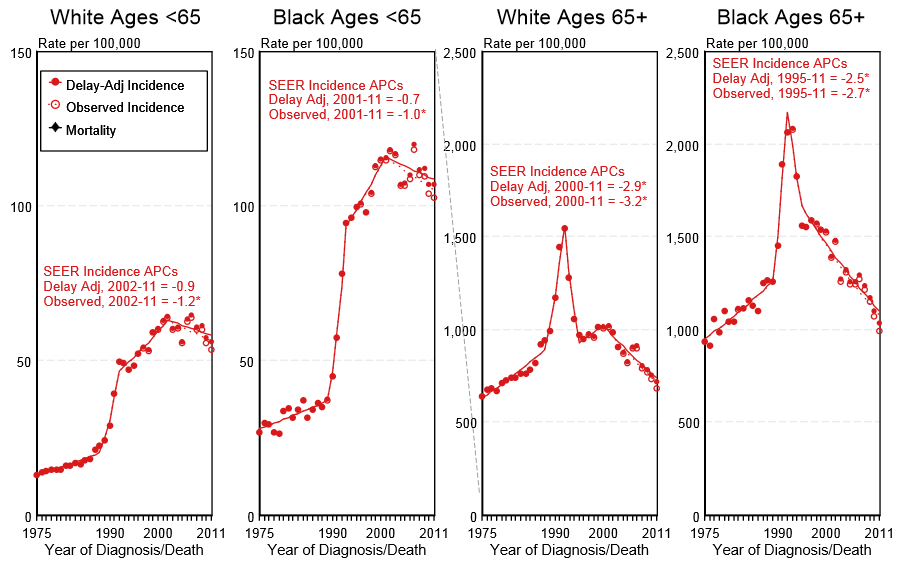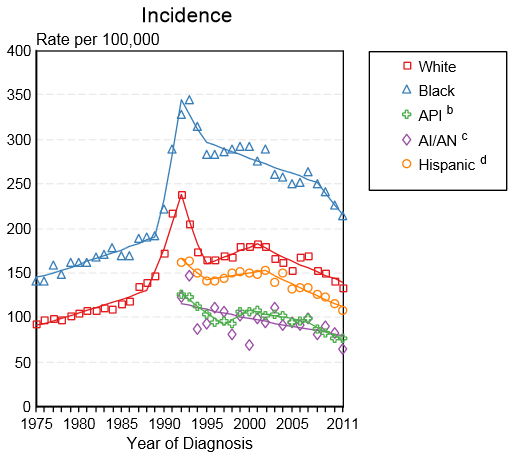Prostate cancer epidemiology and demographics
Editor-In-Chief: C. Michael Gibson, M.S., M.D. [1]; Associate Editor(s)-in-Chief: Rim Halaby, M.D. [2]
|
Prostate cancer Microchapters |
|
Diagnosis |
|---|
|
Treatment |
|
Case Studies |
|
Prostate cancer epidemiology and demographics On the Web |
|
American Roentgen Ray Society Images of Prostate cancer epidemiology and demographics |
|
Risk calculators and risk factors for Prostate cancer epidemiology and demographics |
Overview
In 2012, the prevalence of prostate cancer was estimated to be 2,800 cases per 100,000 men in the United States. In 2015, the incidence of prostate cancer was estimated to be 139.6 cases per 100,000 men in the United States. The majority of prostate cancer cases are reported in the United States. It usually affects individuals of the African American race. Asian, Hispanic and White individuals are less likely to develop prostate cancer.
Epidemiology and Demographics
Prevalence
- In 2012, there were an estimated 2,800 per 100,000 men living with prostate cancer in the United States.[1]
- In the United States, the age-adjusted prevalence of prostate cancer is 1,690 per 100,000 in 2011.[2]
- Rates of prostate cancer vary widely across the world. Although the rates vary widely between countries, it is least common in South and East Asia, more common in Europe, and most common in the United States.[3]
- In the United Kingdom it is also the second most common cause of cancer death after lung cancer, where around 35,000 cases are diagnosed every year and of which around 10,000 die of it. However, many men who develop prostate cancer never have symptoms, undergo no therapy, and eventually die of other causes. That is because malignant neoplasms of the prostate are, in most cases, slow-growing, and because most of those affected are over 60. Hence they often die of causes unrelated to the prostate cancer, such as heart/circulatory disease, pneumonia, other unconnected cancers or old age.
Incidence
- In 2015, it is estimated that there will be 220,800 new cases of prostate cancer and an estimated 27,540 people will die of this disease.[1]
- The number of new cases of prostate cancer was 137.9 per 100,000 men per year. The number of deaths was 21.4 per 100,000 men per year. These rates are age-adjusted and based on 2008-2012 cases and deaths.[1]
- In 2011, the delay-adjusted incidence of prostate cancer was estimated to be 145.2 per 100,000 men in the United States.[2]
- In 2011, the age-adjusted incidence of prostate cancer was 139.89 per 100,000 men in the United States.[2]
Age
- The incidence of Prostate cancer increases with age; the median age at diagnosis is 66 years.
- While the overall age-adjusted incidence of prostate cancer in the United States between 2007 and 2011 is 147.6 per 100,000, the age-adjusted incidence of prostate cancer by age category is:[2]
- Under 65 years: 57.8 per 100,000
- 65 and over: 768.2 per 100,000
- Shown below is an image depicting the incidence of prostate cancer by age and race in the United States between 1975 and 2011.[2]
Race
- According to the American Cancer Society, prostate cancer is least common among Asian men and most common among black men, with figures for white men in-between.[4][5] However, these high rates may be affected by increasing rates of detection.[6]
- Shown below is a table depicting the age-adjusted prevalence of prostate cancer by race in 2011 in the United States.[2]
| All Races | White | Black | Asian/Pacific Islander | Hispanic | |
| Age-adjusted prevalence | 1690 per 100,000 | 1680 per 100,000 | 2610 per 100,000 | 870 per 100,000 | 1320 per 100,000 |
- Shown below is an image depicting the incidence of prostate cancer by race in the United States between 1975 and 2011.[2]
API: Asian/Pacific Islander; AI/AN: American Indian/ Alaska Native
References
- ↑ 1.0 1.1 1.2 National Cancer Institute. Surveillance, Epidemiology, and End Results Program 2015. http://seer.cancer.gov
- ↑ 2.0 2.1 2.2 2.3 2.4 2.5 2.6 Howlader N, Noone AM, Krapcho M, Garshell J, Miller D, Altekruse SF, Kosary CL, Yu M, Ruhl J, Tatalovich Z,Mariotto A, Lewis DR, Chen HS, Feuer EJ, Cronin KA (eds). SEER Cancer Statistics Review, 1975-2011, National Cancer Institute. Bethesda, MD, http://seer.cancer.gov/csr/1975_2011/, based on November 2013 SEER data submission, posted to the SEER web site, April 2014.
- ↑ "IARC Worldwide Cancer Incidence Statistics—Prostate". JNCI Cancer Spectrum. Oxford University Press. December 19, 2001. Retrieved on 2007-04-05 through the Internet Archive
- ↑ Overview: Prostate Cancer—What Causes Prostate Cancer? American Cancer Society (2006-05-02). Retrieved on 2007-04-05
- ↑ Prostate Cancer FAQs. State University of New York School of Medicine Department of Urology (2006-08-31). Retrieved on 2007-04-05
- ↑ Potosky A, Miller B, Albertsen P, Kramer B (1995). "The role of increasing detection in the rising incidence of prostate cancer". JAMA. 273 (7): 548&ndash, 52. doi:10.1001/jama.273.7.548. PMID 7530782.

